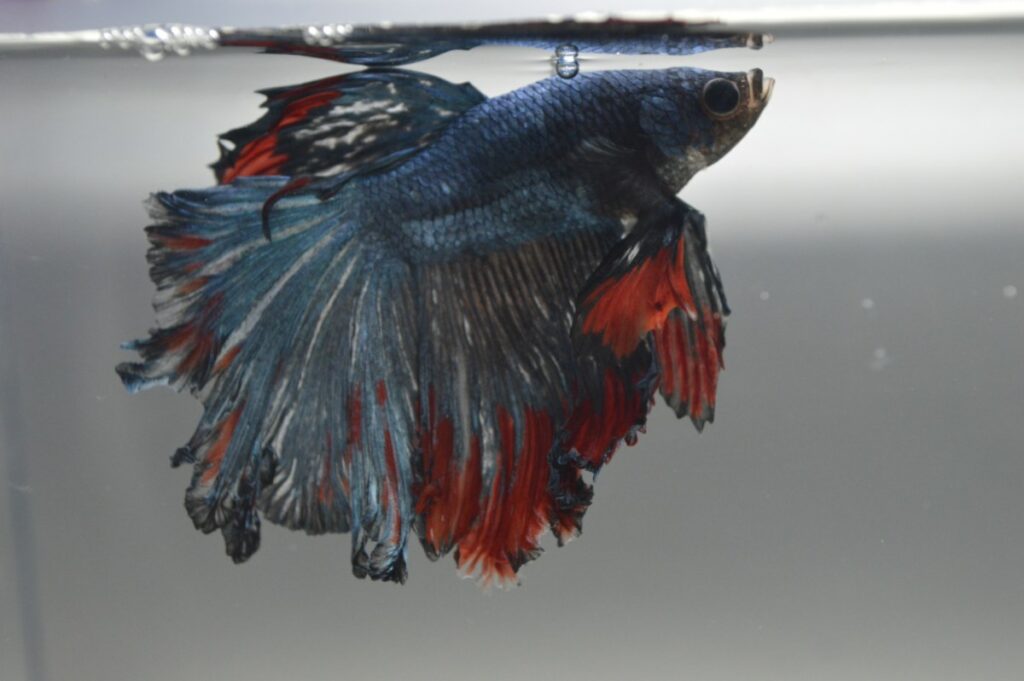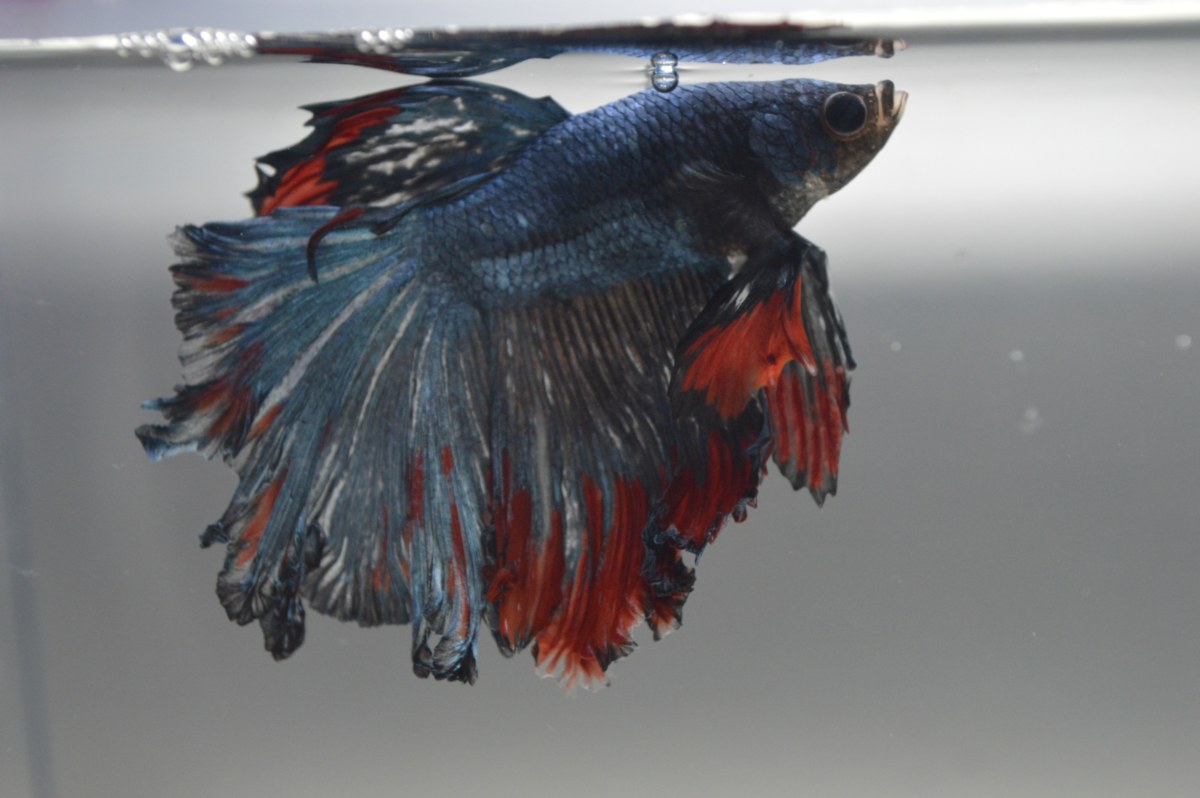The vibrant fins are one of the trademarks of betta fish. Potential buyers and pet shop shoppers can’t help but stop and admire their beautiful fins.
They’re what draw many people into betta fish at first and make them fall in love.
But their beautiful fins are also prone to disease and damage, like betta fish fin rot and fin loss. Most hobbyists don’t know the difference between betta fin rot vs. fin loss and consider both to be the same.
However, fin rot and fin loss are two different betta illnesses that occur due to varied situations. Keep scrolling to understand in detail about betta fish fins loss and betta fish fins rot, their causes, symptoms, as wells preventive measures.
Betta fish fin loss: what it is and common causes
Betta fin loss happens due to physical damage occurs to the betta fin tissue. It’s not the result of a disease or a fungal or bacterial infection. Some of the common causes of betta fish fin loss are as follows.
Sharp tank decorations

If you have kept sharp tank decorations like plastic plants, sharp-edged rocks, driftwood, the betta fish may get snagged fins.
Here are two solutions: remove the sharp objects, or, if you feel they are necessary, use a nylon cloth to cover the sharp or rough decorations.
Try to replace plastic plants with live plants, which not only will limit fin loss but also will provide a good aquarium environment.
Lastly, aside from tank decorations, make sure there are no rough substrates like rocks with rough edges. When the fish swim above the rough substrates, they may damage their fins, so ensure that there are none.
Bullying and fin nipping
Another common reason for fin loss is bullying and fin nipping.
As bettas are an aggressive fish, you likely won’t be able to keep multiple betta fish in the same tank together. You can try to keep multiple females together but there is a chance they will nip at one another and you must take adequate care to ensure they are compatible.
You may also notice—when breeding—that a male might occasionally nip at a female betta. But if they live in a community tank, it is quite common; especially if you keep it with other fin nipping fish.
Ammonia poisoning
Ammonia poisoning is another reason betta fish may experience fin loss. But ammonia poisoning does not show effects immediately. If a betta fish goes through fin loss due to this reason, it means it has been exposed to an ammonia infection for an extended period.
You can detect ammonia poisoning when the betta fish shows symptoms like rapid breathing, lethargy, fin clamping, or gill redness. These symptoms will occur before fin loss, so keep a lookout.
If you notice this happening, please contact your vet or local aquatic store to point you in the right direction.
Tail biting
Betta fish may bite its own tail because of aggression, stress, or laziness, which will ultimately lead to fin loss.
To prevent stress, you should make sure the tank environment is set up properly with lots of hiding places for your betta fish.
Tips to cure betta fin loss
There are ways to ensure your betta stays safe in the fish tank. If you ever see bloody fin tips or notice a significant loss in the fins, don’t panic. As long as a betta fin loss isn’t the result of bacterial infection, reviving betta’s fins completely possible. Here are some of tips for cuing betta fin loss.
Don’t keep aggressive tank mates
Damaged fins, split fins, or fin loss, in general, is most often the result of having aggressive fish as tank mates with your betta. To avoid this, the best thing you can do is keep your betta away from other fin nipping fish in the betta tank.
Improve water quality
To avoid conditions like ammonia infection and fish stress, you should ensure that the tank water is free of toxins to keep a healthy fish. Regularly check water parameters as poor water quality will make your fish suffer, causing betta fin loss.
Slime coat booster + anti-stress additive
Fish naturally have a slime coat that protects their fins and other body parts from any sort of damage. You also get a slime coat booster using which you can ensure betta fish’s fins stay even more protective. You can use API stress coat, which is a great water conditioner that makes tap water safe. Some people choose to only use an API stress coat when their fish are stressed, such as during water changes. Make sure to read the directions on the bottle before using this for your betta.
Prevention
Before you get the betta fish for your home aquarium, you should first educate yourself about the possible things that can harm bettas. To avoid betta fins from getting hurt or damaged, ensure that there are no living or non-living objects that can lead to fin loss.
Some of the basic preventive measures you can adopt are avoiding plastic plants, sharp objects, and jagged decorative items, and ensuring you keep your betta right the right tank mates.
Betta fish fin rot: what it is and common causes

Unlike fin loss, which is caused by mainly physical damage, fin rot is a disease. Fin rot happens because of poor water quality, which causes bacterial growth in the betta fins. Fin rot is one of the most common ailments in betta fish, and severe fin rot can even make your betta die.
Here are some of the common fin rot symptoms your betta fish is getting bacterial fin rot:
- Blackened fin edges
- Bloody fin tips
- Rapid fin tissue loss
- White film on the fins (in case of fungal infections)
- Jagged fin edges (in case of bacterial fin rot)
Keep a lookout for these signs to detect fin rot in your aquarium. Now let’s consider some of the common causes your betta fish might be experiencing fin rot symptoms.
Ill-maintained aquarium
If you are not maintaining aquarium hygiene, it will create toxin growth like an increase in ammonia and nitrate. Additionally, unstable water parameters like changes in water temperature and pH levels can make the betta fish succumb to mild to moderate fin rot.
The ideal ammonia level should be at 0ppm, and the ideal nitrate level should be at 20ppm. Water temperature should also be stable with little or no fluctuation to not stress the betta fish.
Bacterial or fungal growth
Bacterial or fungal growth is a common cause of betta’s fin rot. Bacterial infection is a disease that occurs when a fungus or bacteria called Pseudomonas Fluorescent grows in betta’s fins. You can detect fungal or bacterial infections by looking at the rot or fin.
If it’s a fungal infection, the fin edges will get even and smooth. You will notice that there is a white film or edge on the rot or fin. In bacterial fin rot, you won’t notice any white film; instead, the fish will have jagged or uneven edges.
But how does bacteria or fungal growth takes place? Bacteria can enter the betta’s tank through other fish that might carry the infection. Besides, if you are not maintaining hygiene in the tank or are unable to introduce good bacteria, such problems become common.
Improper water temperature
Improper temperature is another cause of betta fin rot. Bettas need a warmer temperature to live comfortably in the aquarium, so you need to ensure that the water temperature is between 75 to 80 degrees F in the betta’s tank at all times, without which the fish can experience fin damage.
Improper water hardness
Water hardness is the amount of magnesium and calcium dissolved in the water. Hard water has more of these minerals, while soft water has fewer minerals. An ideal hardness to avoid fin rot is between 3 to 4 dGH (Degrees of General Hardness).
Stress
Betta fin rot may occur due to excessive stress. Stress again is related to the aquarium condition, which can affect the betta’s immune system. If the betta tank has poor water quality, aggressive tank mates, or not enough nesting space, the fish gets stressed, and its delicate fins start to rot.
Tips to cure betta fin rot
Curing betta fin rot is possible if you notice the signs early. If it’s not a severe fin rot, treatment is even easier. Here are some expert-recommended measures to recover the rotten betta fin tissue.
Clean the aquarium
If the fin rot is minor, meaning only less than half of the fin has rotten, you can cure it by just cleaning the water tank. Once you put back the betta into the tank, make sure it does not come in contact with any toxins while the fins heal.
In the healing process, new fin growth takes place; however, they are very delicate at this stage. Mild fin rot treatment may also include the use of medications apart from cleaning the tank. MELAFIX Bacterial Remedy is a widely used medication that can cure the betta fish immediately.
Change water parameters
If the water parameters are not ideal, losing fins becomes common. Inadequate water parameters are another cause of bacterial growth; hence the best way to stop such growth is by changing water parameters immediately.
Make sure the water pH level is between 6.8-7.5, the temperature is between 75-80 degrees F, and the water hardness is between 3-4 dGh. Betta fin regeneration is possible only if the water parameters remain stable.
Aquarium salt
Aquarium salt is an effective antibiotic to treat betta fin rot. You will need one tablespoon of salt per five gallons of water. To add the same, get some of the aquarium’s water into a cup and mix the salt into the cup of water. Add the salt in this way as you don’t want to add the salt directly to your aquarium. Also keep in mind that not all fish can withstand aquarium salt, so if there are other fish in the tank, you should consider transferring them first to a safer tank.
Wrapping Up
Betta fin or tail rot and fin loss are common conditions found in the betta fish. But new fin tissue formation isn’t impossible if you take quick and early action. Therefore, closely monitor your betta’s health to see any signs of bacterial infection, check water quality, and follow all hygiene measures to ensure your fish lives a long healthy life.
FAQs
Yes, they grow back if the fin rot or loss isn’t severe and you take early action.
You will notice bloody fin tips, blackened fin edges, and white film on the edges if the betta is suffering from fin rot.
Fin melt is quite similar to fin rot. It is a disease where the fish’s fins melt or rot due to bacterial infection, poor tank water conditions, stress, and the like.

